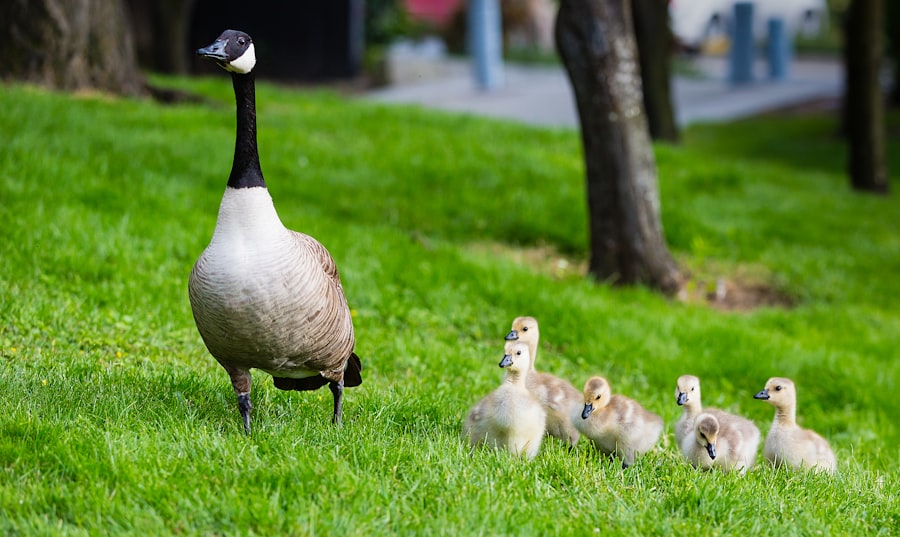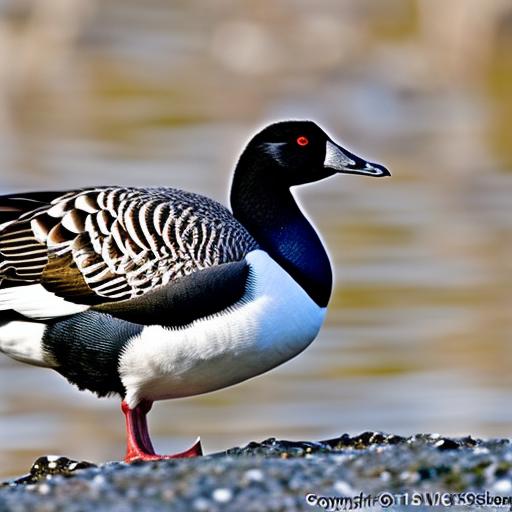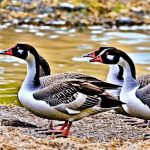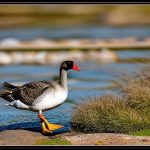Geese breeds play a significant role in Canadian agriculture. They are not only a source of food and income but also contribute to the overall health and sustainability of the agricultural industry. In Canada, there are several popular breeds of geese that are commonly raised for their meat, eggs, and feathers. These breeds have unique characteristics and traits that make them well-suited for Canadian climates and farming practices.
Key Takeaways
- Canada has a diverse range of geese breeds, each with unique characteristics and roles in agriculture.
- Popular breeds in Canada include the Embden, Toulouse, and Chinese geese.
- Understanding the physical appearance, behavior, and temperament of geese breeds is important for successful farming.
- Geese have a long history in Canadian agriculture, dating back to the early settlers.
- Preserving geese breeds in Canada is crucial for maintaining genetic diversity and ensuring the sustainability of the industry.
The Popular Breeds of Geese in Canada
The most common geese breeds in Canada include the Embden, Toulouse, and Chinese geese. The Embden goose is known for its large size and white feathers. It is a popular breed for meat production due to its fast growth rate and high meat yield. The Toulouse goose, on the other hand, is known for its gray feathers and calm temperament. It is often raised for both meat and egg production. The Chinese goose is smaller in size compared to the Embden and Toulouse geese but is highly valued for its egg-laying abilities.
Understanding the Characteristics of Canadian Geese Breeds
Each breed of geese in Canada has unique traits and behaviors that are important to understand for proper care and management. For example, Embden geese are known to be hardy and adaptable to different climates, making them suitable for Canadian farming conditions. Toulouse geese, on the other hand, are known for their calm temperament and ease of handling. Chinese geese are excellent egg layers but can be more aggressive compared to other breeds.
Understanding these characteristics is crucial for farmers to provide appropriate housing, nutrition, and healthcare for their geese. It also helps in managing their behavior and ensuring their overall well-being.
The History and Origin of Geese Breeds in Canada
The history of geese breeds in Canada dates back to the early European settlers who brought domesticated geese with them from their home countries. Over time, these geese adapted to the Canadian climate and developed unique characteristics that made them well-suited for the local conditions.
Geese have played a significant role in Canadian agriculture throughout history. They were not only a source of food but also provided feathers for bedding and clothing. In addition, geese were used as guard animals to protect crops from pests and predators. Their droppings also served as valuable fertilizer for the fields.
The Role of Geese Breeds in Canadian Agriculture
Geese breeds continue to play a crucial role in Canadian agriculture today. They contribute to the economy and food production by providing meat, eggs, and feathers. The meat from geese is highly valued for its flavor and tenderness, making it a popular choice among consumers. Geese eggs are also sought after for their rich taste and nutritional value.
Furthermore, geese breeds help maintain the ecological balance in agricultural ecosystems. They graze on grass and weeds, reducing the need for chemical herbicides and promoting natural pest control. Their droppings enrich the soil with nutrients, improving its fertility and productivity.
The Different Types of Domestic Geese in Canada

In addition to the popular breeds mentioned earlier, there are several other types of domestic geese found in Canada. These include the African goose, Sebastopol goose, and Pilgrim goose, among others.
The African goose is known for its large size and distinctive knob on its beak. It is primarily raised for meat production but also lays a decent number of eggs. The Sebastopol goose is famous for its curly feathers, which give it a unique appearance. It is primarily raised for ornamental purposes but can also be used for meat and egg production. The Pilgrim goose is a smaller breed that is known for its ability to sex itself at a young age, making it easier to manage breeding programs.
The Unique Features of Canadian Geese Breeds
Canadian geese breeds have unique features and traits that set them apart from their counterparts in other countries. These features have developed over time due to the specific environmental conditions and farming practices in Canada.
For example, Canadian geese breeds are known for their hardiness and adaptability to cold climates. They have thick layers of feathers that provide insulation and protect them from harsh weather conditions. Their strong immune systems also help them resist common diseases and infections.
The Physical Appearance of Geese Breeds in Canada
The physical appearance of geese breeds in Canada varies depending on the breed. The Embden goose is the largest breed, with a plump body, long neck, and white feathers. The Toulouse goose is slightly smaller but has a similar body shape and gray feathers. The Chinese goose is the smallest breed, with a compact body and a mix of white and gray feathers.
In terms of size, the Embden goose can weigh up to 30 pounds, while the Toulouse goose typically weighs around 20 pounds. The Chinese goose is the smallest, weighing between 10-12 pounds on average.
The Behavior and Temperament of Geese Breeds in Canada
The behavior and temperament of geese breeds in Canada can vary depending on the breed and individual characteristics. However, there are some general traits that are common among Canadian geese breeds.
Geese are social animals that form strong bonds with their flock mates. They are highly territorial and will defend their territory against intruders. Geese are also known for their honking calls, which they use to communicate with each other.
In terms of temperament, Embden geese are generally calm and docile, making them easy to handle. Toulouse geese are also known for their calm temperament but can be more protective of their nests during breeding season. Chinese geese can be more aggressive compared to other breeds, especially when they feel threatened.
The Importance of Preserving Geese Breeds in Canada
Preserving geese breeds in Canada is crucial for several reasons. Firstly, these breeds have unique characteristics and traits that make them well-suited for Canadian farming conditions. Losing these breeds would mean losing valuable genetic diversity and the ability to adapt to changing environmental conditions.
Secondly, geese breeds contribute to the overall health and sustainability of the agricultural industry. They provide a source of income and food for farmers, as well as contribute to the ecological balance in agricultural ecosystems.
Lastly, preserving geese breeds is important for cultural and historical reasons. Geese have been a part of Canadian agriculture for centuries and have played a significant role in shaping the country’s farming practices and traditions.
In conclusion, geese breeds play a vital role in Canadian agriculture. They provide meat, eggs, and feathers, contribute to the economy, and help maintain the ecological balance in agricultural ecosystems. Understanding the unique characteristics and traits of Canadian geese breeds is crucial for proper care and management. Preserving these breeds is important for maintaining genetic diversity, adapting to changing environmental conditions, and preserving cultural and historical traditions. It is essential that we take action to protect and preserve these valuable animals for future generations.
If you’re interested in learning more about breeds of geese in Canada, you might also find this article on poultrywizard.com helpful. It provides valuable information on what to feed ducks, which can be useful for those who are considering raising geese as well. Understanding the dietary needs of waterfowl is essential for their health and well-being. To read the article, click here: https://poultrywizard.com/keeping-ducks/what-should-you-feed-ducks/.
FAQs
What are the most common breeds of geese in Canada?
The most common breeds of geese in Canada are the Canada Goose, Snow Goose, and Ross’s Goose.
What is the size of a Canada Goose?
Canada Geese are large birds, with a wingspan of up to 6 feet and a weight of up to 14 pounds.
What is the purpose of raising geese in Canada?
Geese are raised in Canada for their meat, eggs, and feathers. They are also used for weed control and as pets.
What is the lifespan of a goose?
The lifespan of a goose can vary depending on the breed, but on average they can live up to 20 years.
What is the difference between a domestic goose and a wild goose?
Domestic geese are raised by humans for various purposes, while wild geese live in their natural habitat and are not domesticated. Domestic geese are usually larger and have a more docile temperament than wild geese.
What is the breeding season for geese in Canada?
The breeding season for geese in Canada typically begins in March and lasts until June.
What is the habitat of geese in Canada?
Geese in Canada can be found in a variety of habitats, including wetlands, fields, and urban areas. They are adaptable birds and can thrive in many different environments.
What is the migration pattern of geese in Canada?
Many geese in Canada migrate south for the winter, typically to the southern United States or Mexico. They begin their migration in the fall and return to Canada in the spring.
Meet Walter, the feathered-friend fanatic of Florida! Nestled in the sunshine state, Walter struts through life with his feathered companions, clucking his way to happiness. With a coop that’s fancier than a five-star hotel, he’s the Don Juan of the chicken world. When he’s not teaching his hens to do the cha-cha, you’ll find him in a heated debate with his prized rooster, Sir Clucks-a-Lot. Walter’s poultry passion is no yolk; he’s the sunny-side-up guy you never knew you needed in your flock of friends!







